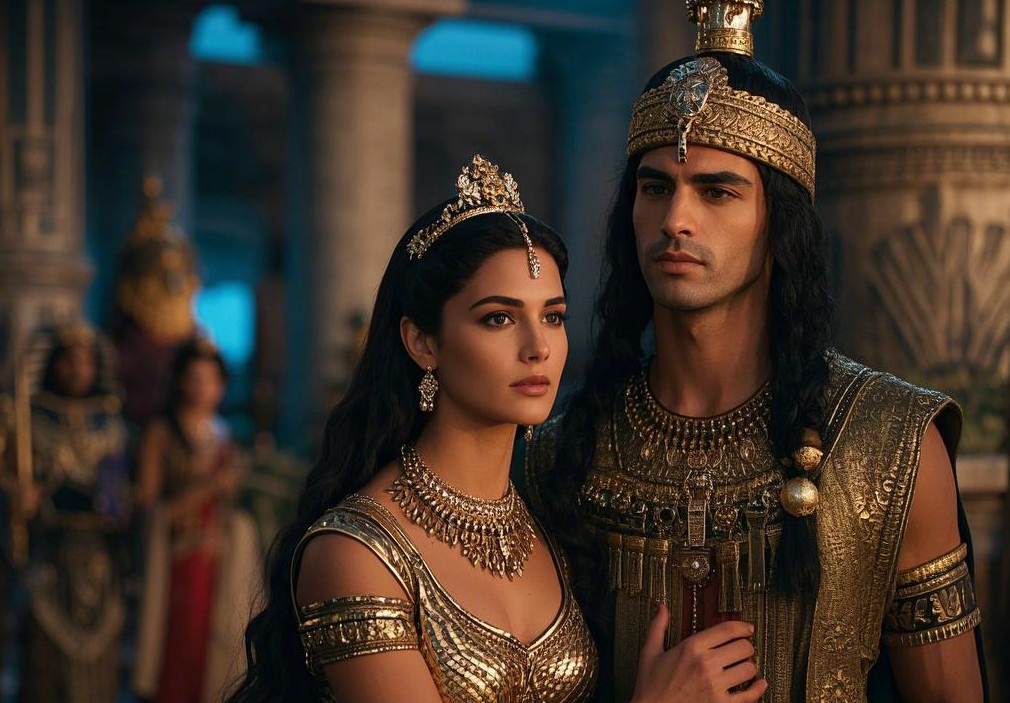A Love in Ancient Egypt
In the land of the Nile, under the blazing sun of ancient Egypt, a love story was about to unfold, one that would span the gap between the highest echelons of power and the common people.
The great Pharaoh Amenhotep IV reigned over Egypt with a vision of change. His rule was marked by a shift in religious beliefs and a new era of art and architecture. The royal palace, with its towering columns and elaborate hieroglyphics, was a symbol of his might and authority.
Among the commoners in the bustling city of Thebes, there lived a young woman named Nefertari. She was a weaver by trade, with nimble fingers that could create the most intricate patterns on linen. Her skin was kissed by the sun, and her eyes, as deep as the Nile itself, sparkled with curiosity and intelligence. Her long, dark hair was usually tied back in a simple braid, but when it was let loose, it flowed like a river down her back.
One day, Pharaoh Amenhotep IV decided to visit the markets of Thebes to see the life of his people firsthand. As he walked through the crowded stalls, he was drawn to a beautiful tapestry on display at Nefertari's booth. The tapestry depicted scenes of daily life along the Nile, with fishermen casting their nets, farmers tilling the land, and children playing on the banks.
Amenhotep IV was so taken by the tapestry that he asked to meet the artist. When Nefertari stepped forward, the Pharaoh was immediately struck by her beauty and grace. Nefertari, on the other hand, was nervous in the presence of the powerful ruler, but she summoned the courage to speak to him about her art.
They talked for a while, with Amenhotep IV asking about the inspiration behind her work and Nefertari sharing her observations of the world around her. The Pharaoh was impressed not only by her talent but also by her wisdom and insight. From that day on, Amenhotep IV made it a point to visit Nefertari whenever he could.
As time passed, their conversations grew more intimate, and a deep love blossomed between them. However, their relationship was not without its obstacles. In ancient Egypt, the Pharaoh was considered a god - king, and his marriage was often a political alliance. The royal advisors and the priesthood were horrified when they learned of the Pharaoh's love for a commoner.
They tried to persuade Amenhotep IV to end the relationship and marry a princess from a neighboring kingdom to strengthen Egypt's political position. The Pharaoh was torn. He loved Nefertari deeply, but he also felt the weight of his responsibilities as a ruler.
Nefertari, too, was aware of the difficulties they faced. She didn't want to cause trouble for the Pharaoh, but she couldn't bear the thought of losing him. One day, she had an idea. She knew that the Pharaoh was planning a grand temple to honor the new sun god he had introduced. She offered to use her skills as a weaver to create beautiful tapestries to adorn the temple.
The Pharaoh agreed, and Nefertari set to work. She spent months creating intricate tapestries that depicted the glory of the new religion and the power of the Pharaoh. When the temple was completed and the tapestries were unveiled, they were a sensation. The people of Egypt were in awe of Nefertari's talent, and the royal advisors and the priesthood had to admit that she had made a significant contribution to the kingdom.

In the years that followed, Amenhotep IV and Nefertari ruled Egypt with wisdom and compassion. They had several children, and their family was a symbol of the love that could overcome even the greatest of obstacles. Their story was told and retold throughout Egypt, becoming a part of the country's rich history and a testament to the power of love in a land of ancient mysteries. And as the sands of time continued to shift, their love story remained a shining example of how true love could endure, even in the face of the strictest social hierarchies and political pressures.